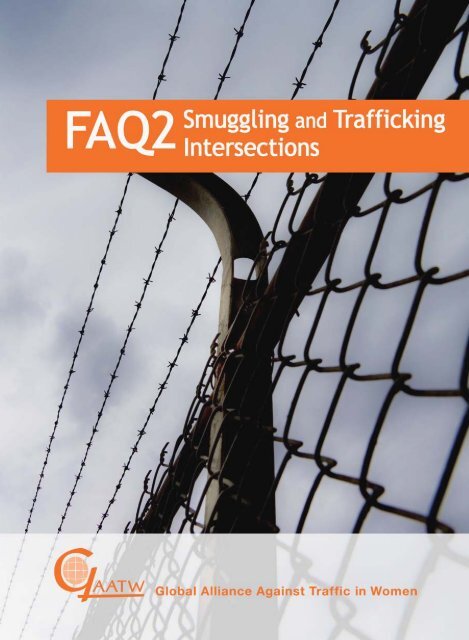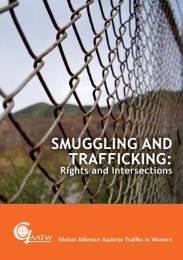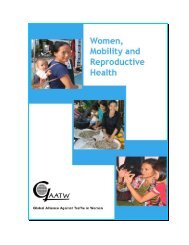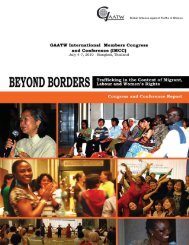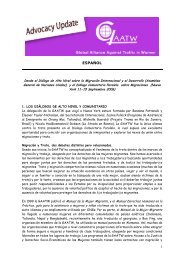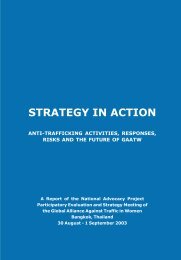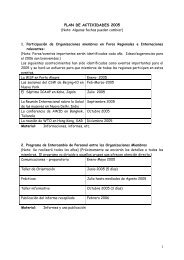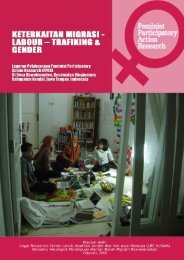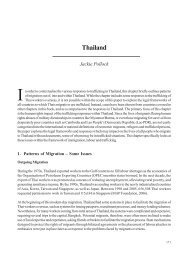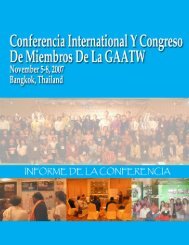FAQ 2: Smuggling and Trafficking Intersections - Global Alliance ...
FAQ 2: Smuggling and Trafficking Intersections - Global Alliance ...
FAQ 2: Smuggling and Trafficking Intersections - Global Alliance ...
Create successful ePaper yourself
Turn your PDF publications into a flip-book with our unique Google optimized e-Paper software.
<strong>FAQ</strong>2:SMUGGLING ANDTRAFFICKINGINTERSECTIONS<strong>Global</strong> <strong>Alliance</strong> Against Traffic in Women<strong>FAQ</strong> 2: SMUGGLING AND TRAFFICKING INTERSECTIONS3
WHAT ARE MIGRANTSMUGGLING ANDHUMAN TRAFFICKING?A person’s migration story can include both smuggling <strong>and</strong> trafficking,experienced at the same time or at different times.Key definitions of migrant smuggling <strong>and</strong> trafficking in persons are found intwo Protocols to the United Nations Convention Against TransnationalOrganised Crime (UNTOC).In the Protocol on Migrant <strong>Smuggling</strong>, smuggling is defined as:“the procurement, in order to obtain, directly orindirectly, a financial or other material benefit, of theillegal entry of a person into a State Party of which theperson is not a national or a permanent resident.” 1In the <strong>Trafficking</strong> Protocol, trafficking is defined as:“the recruitment, transportation, transfer, harbouring orreceipt of persons, by means of the threat or use of forceor other forms of coercion, of abduction, of fraud, ofdeception, of the abuse of power or of a position ofvulnerability or of the giving or receiving of paymentsor benefits to achieve the consent of a person havingcontrol over another person, for the purpose ofexploitation.” 2<strong>FAQ</strong> 2: SMUGGLING AND TRAFFICKING INTERSECTIONS5
*** These definitions may be slightly different from those adopted by States in nationallegislation.***Countries that ratify the <strong>Smuggling</strong> Protocol are required to criminalise migrantsmuggling (though not migrants themselves), along with related actions suchas producing, procuring or possessing a fraudulent travel or identity document,<strong>and</strong> enabling a non-national to illegally stay in a country, when these thingsare done for profit. Some countries include these elements in nationaldefinitions of smuggling.In smuggling, the defining feature is helping another person irregulary entera country, when this is done for profit. In trafficking, the defining feature isnot so much whether or not a country’s migration laws have been broken asthe presence of exploitation. Of course, a person can start out as a smuggledmigrant, only to find they have been moved into a situation that is inherentlyexploitative. However, this is not always the case (see Overlap section onpage 9).6
WHAT ARE THEDIFFERENCES BETWEENSMUGGLING ANDTRAFFICKING?Migrant smuggling <strong>and</strong> trafficking in persons are different legal concepts.However, they do overlap. According to the UN definitions, differences betweenthe two include the following. (Note that national definitions may vary.):• <strong>Smuggling</strong> involves moving someone across aninternational border for profit, while trafficking can occurwithin or across borders <strong>and</strong> is always for the purpose ofexploitation. 3• The UN smuggling definition does not mention amigrant’s consent. Concepts around force are howeverrelevant in trafficking, where a person is moved against his orher will or deceitfully. (See section on Consent)• In smuggling, the State’s border has been violated byirregular border crossing, while in trafficking, a person isthe victim of violations. Even though the State’s border hasbeen crossed irregularly in smuggling, under the <strong>Smuggling</strong>Protocol migrants in smuggling situations are not criminals. 4However, States can charge people under domestic law forother offenses than having been smuggled. 5 In contrast totrafficked persons, migrants in smuggling situations are notnecessarily victims of crime. They may have suffered no harmor injury in the migration process. However, like any other<strong>FAQ</strong> 2: SMUGGLING AND TRAFFICKING INTERSECTIONS7
migrant or indeed any other person, they can still become avictim of crime. Migrants can face a number of risks in thesmuggling process, including theft, extortion, rape, assault<strong>and</strong> even death at the h<strong>and</strong>s of smugglers. As noted above,some smuggling situations descend into becoming traffickingsituations.• Migrants in smuggling situations receive <strong>and</strong> are legallydue very little assistance or access to remedies, whiletrafficked persons can usually access these more readily.Migrants in smuggling situations are often criminalised, facingarrest, detention <strong>and</strong> deportation.8
WHEN DO SMUGGLINGAND TRAFFICKINGOVERLAP?We all approached <strong>and</strong> paid a smuggler to get out ofBurma, <strong>and</strong> sometimes it was the case that the personwould lie to us <strong>and</strong> exploit us once in Thail<strong>and</strong>. In thatcase, you can be both smuggled <strong>and</strong> trafficked.-Burmese woman at a MAP Foundation workshop,Chiang Mai, Thail<strong>and</strong>, March 2011<strong>Smuggling</strong> <strong>and</strong> trafficking happen at the same time when a person’s experiencemeets both definitions, ie. they are taken over an international border in anirregular <strong>and</strong> forced or deceptive way for profit <strong>and</strong> exploited.Many migrants experience some aspects of the trafficking definition but not all.Perhaps they are moved <strong>and</strong> exploited but have not been forced. For adultstheir experience needs all three elements to create the offence of trafficking inpersons under international law <strong>and</strong> under the law of many countries. Eventhough someone might have experienced something that is nearly trafficking,they are not considered in the same way; <strong>and</strong> they are held culpable for breakingimmigration laws.Though smuggling <strong>and</strong> trafficking can both happen in a person’s migration experience,GAATW members <strong>and</strong> allies are also cautious, not wanting trafficking to be equatedwith smuggling in a way that causes denial of rights for trafficked persons, or viceversa. In a 2010 letter to the Malaysian Prime Minister, Human Rights Watchexpressed concern about the addition of anti-smuggling elements in their anti-traffickinglegislation, saying that the law leads to conflation of the two which risks traffickingvictims being treated as smuggled migrants <strong>and</strong> subject to deportation 6 - a responsethat is unacceptable to non-trafficked migrants as well. 7<strong>FAQ</strong> 2: SMUGGLING AND TRAFFICKING INTERSECTIONS9
HOW DO SMUGGLINGAND TRAFFICKINGINTERSECT IN TERMS OFCONSENT?Many see a main divide between smuggling <strong>and</strong> trafficking as one of consent. 8Contrary to what most people believe about smuggling, the <strong>Smuggling</strong> Protocol’sdefinition does not mention consent. And highlighting consent in smugglingoften only serves to criminalise or stigmatise migrants. Advocates can be astutein talking about smuggling in order not to further stereotypes - they do not haveto ascribe consent to people in smuggling situations.Excepting children, the <strong>Trafficking</strong> Protocol’s definition of trafficking does requireforce or other deceptive or coercive means to be present. Most actors, includingGAATW in past training material, say that smuggled people must haveconsented, some in order to highlight that trafficked people do not consent butare forced victims. 9Cases from Burma show, however, that sometimes trafficked people do consentto exploitation when survival is at stake:“The majority of trafficking victims in Burma were notkidnapped, but rather willingly consented to accompanytraffickers [migration brokers], only to find out later thatthey had been deceived… In order to [support their families]many also consent to exploitative types of work. The linebetween trafficking <strong>and</strong> smuggling becomes increasinglyblurry, as it is almost impossible to discern whether consenttruly exists for those people who find themselves in direeconomic situations.” 1010
In this example there is both consent <strong>and</strong> force present. People canconsent initially <strong>and</strong> then find themselves exploited later; or they can consentthough they may also feel forced to move out of a lack of other livelihood orsafety options. The reality is blurry.HOW DO SMUGGLINGAND TRAFFICKINGINTERSECT INPREVENTION?Anti-smuggling measures rely heavily on blocking migration,which makes movement more dangerous for all migrants.Not only do anti-smuggling measures harm trafficked people <strong>and</strong> all migrants,but some governments argue that their anti-smuggling measures are actuallyhelping the anti-trafficking cause – something we do not accept.Their logic is that if people do not enter a destination country, then theycannot be exploited (<strong>and</strong> thus trafficked) there. 11 But the reality is that thisleads to people taking more dangerous migration routes <strong>and</strong> being moredependent on <strong>and</strong> at risk of abuse by migration brokers.For instance, in September 2009 French authorities destroyed a migrantcamp in France, a temporary home to people hoping to reach the UK. TheBritish Home Secretary said the camp’s destruction would not only serve to“prevent illegal immigration, but also to stop people trafficking.” 12 As a result,<strong>FAQ</strong> 2: SMUGGLING AND TRAFFICKING INTERSECTIONS11
287 people were detained; 13 about 2000 migrants spread to other sites onthe French coast; <strong>and</strong> the price of assisted migration doubled. 14Prevention of movement can cause increased risks <strong>and</strong> dependencies.Several studies show this:• Netherl<strong>and</strong>s 2006 study - Increased crackdowns did notreduce the number of irregular entries, but increasedinvolvement of smugglers. 15• US-Mexico 2004 12-year econometric study – Moreenforcement resulted in migrants substituting routes to lesspatrolled areas, which meant an increase in time costs, health/life costs <strong>and</strong> smugglers’ fees. 16• Palestine-Israel 2008 40-year study – As the bordertightened in the last 10 years, numbers of migrants did notdrop. “The scarcity of work <strong>and</strong> increasingly severe controlsover cl<strong>and</strong>estine workers entering Israel, made Palestinianlabourers even more vulnerable in relation to smugglers.” 17Refugees <strong>and</strong> refugee advocates also find heightenedrestrictions (migration prevention) problematic becauserefugees must enter another country to find safety. Ifrefugees are mislabelled as smuggled or traffickedpeople who need to be kept out, they will be blockedfrom finding safety.12
HOW DO SMUGGLINGAND TRAFFICKINGINTERSECT INIDENTIFICATION?When authorities detain migrants, they do notalways screen for trafficking, but detain them ascriminals, as ‘smuggled’, or as ‘irregular’ <strong>and</strong> thendeport them before they have a chance to havetheir rights recognised.It is often not possible to determine whether a situation is trafficking until theexploitation has actually occurred. For example, if people are found in alorry, some about to suffocate to death <strong>and</strong> some having died already, 18how does anyone know if they are they being smuggled or trafficked?Did the migrants themselves know if the facilitator arranging migrationintended to exploit them at the end destination (equalling trafficking).In both identification at borders <strong>and</strong> further into the migration process, h<strong>and</strong>lingtrafficked persons is financially <strong>and</strong> administratively more burdensome forStates than dealing with ‘smuggled’ people who can be deported. Thereforeborder authorities <strong>and</strong> immigration officials tend to identify people as smuggledrather than trafficked. 19On the other h<strong>and</strong>, there is a tendency for civil society groups to identifymore people as ‘trafficked’ in order for them to obtain rights protections orassistance. It is hard for migrants to have their rights recognised but possiblyhardest for people in smuggling or other undocumented situations who donot fall in protection categories.<strong>FAQ</strong> 2: SMUGGLING AND TRAFFICKING INTERSECTIONS13
“Smuggled people are often excluded from otherprotection determinations on the assumption that theirmotivations are purely economic, <strong>and</strong> their movementpurely voluntary.” 20HOW DO SMUGGLINGAND TRAFFICKINGINTERSECT IN TERMS OFVICTIMHOOD?Trafficked people are legally defined as victims of a crime with rightsto assistance, remedy <strong>and</strong> sometimes, though too rarely, visas to stayin the destination country, while smuggled people are more oftenlegally defined as criminals to be arrested, detained <strong>and</strong> deported.This in turn influences the general public’s attitude to smuggled ortrafficked people. People think smuggling is exploitative <strong>and</strong> cruelwhen it ends in death, but not otherwise. 21While trafficking is renowned for including violations of sexual exploitation,debt bondage, robbery, torture, physical abuse <strong>and</strong> even death, these can<strong>and</strong> do occur in smuggling situations as well. Some national legislation <strong>and</strong>the <strong>Smuggling</strong> Protocol (Article 6,3) refers to some rights-violating actions(endangering life <strong>and</strong> inhuman treatment), as ‘aggravating circumstances’prosecuted with heavier penalties than non-‘aggravated’ situations. While inFreeStockImages.org14
other laws, these ‘aggravating’ actions would translate into ascribingvictimhood <strong>and</strong> then remedies, these are listed solely as a means by whichto measure out longer sentences or harsher punishment to convictedsmugglers.We know that many people in smuggling situations do experienceviolations, but we do not want to victimise people by saying all smuggledmigrants have experienced violations.“Reducing migrants to the status of ‘victims’ will notnecessarily represent their interests or assist them in theiroverall goal of improving their lives or the lives of theirfamilies. Nevertheless, the conditions in which they makethese choices, their treatment on the way <strong>and</strong> in thecountry of destination is something unacceptable tomodern st<strong>and</strong>ards of dignity <strong>and</strong> human treatment.” 22When people in trafficking <strong>and</strong> smuggling situations are seen asvictims, this can lead to a policy solution or other measures of stoppingmigration so that migrating people do not risk coming into contactwith dangers. For example, anti-trafficking prevention programmes aroundthe world have resulted increased border checks or bans on young womenmoving, as well as messages to school children <strong>and</strong> adults that migrating isdangerous, not to mention messages to women that they especially arelikely end up sexually exploited <strong>and</strong> therefore should not leave their village.Advocates highlighting ‘victimhood’ in both smuggling <strong>and</strong> trafficking needto be careful that resultant policy responses do not lead to strict bordercontrol or protectionist prevention messaging as this also leads to humanrights abuses.<strong>FAQ</strong> 2: SMUGGLING AND TRAFFICKING INTERSECTIONS15
HOW DO SMUGGLINGAND TRAFFICKINGINTERSECT IN TERMS OFREMEDIES?Civil society representatives, in some cases, areadvocating for smuggled people to be able to claimcompensation, 23 <strong>and</strong> there are a few attempts at settinga norm for smuggled people to be able to institutejudicial proceedings for remedies.Rights to assistance, justice <strong>and</strong> protection are commonly given at least inlaw to trafficked people but not smuggled people. One exception is in Belgiumwhere smuggled people (who have experienced aggravated circumstancesin smuggling, see Victimhood section) have access to the protection <strong>and</strong>assistance systems for victims of trafficking. 24Article 15 of the UN Office on Drugs <strong>and</strong> Crime Model Law on <strong>Smuggling</strong>, forinstance, says that smuggled people who have been victimized in thesmuggling process should have access to the usual criminal remedies, aswell as the right to institute judicial proceedings to claim compensation.Further, their immigration status or return home should not prevent themaccessing the regular criminal justice system, or payment of compensation. 25A 2009 European Parliament directive includes similar rights to remedy,where employers <strong>and</strong> subcontractors alike are required to pay illegallyemployedthird-country nationals’ outst<strong>and</strong>ing remuneration. 2616
On the next page we show cases where traffickedpeople’s access to remedies are affectedpositively <strong>and</strong> negatively by the smugglingframework – positively because they want toreturn home rather than go through antitraffickingsystems; negatively because they wantredress that would come from being labelled astrafficked, but instead are categorised assmuggled.Some trafficked persons weigh whether the opportunity for redress is worththe potential social or economic consequences. 27 Many trafficked peopleespecially young women, who pass through Bangkok’s migrantdetention centre <strong>and</strong> are screened for trafficking, prefer not to say theyare trafficked because they would have to stay in a closed governmentshelter for two years <strong>and</strong> assist with prosecution. They would prefer toreturn home to either remain with family or migrate again, not wanting toforfeit freedom of movement or an income their family depends on. 28On the other h<strong>and</strong>, rather than wanting to be treated as ‘smuggled’,‘undocumented’ or ‘irregular’, some trafficked people want to be givenaccess to rights <strong>and</strong> redress that are due to people who have experiencedtrafficking. In the case study (next page), a woman cooperated in the legalproceedings to prosecute her trafficker <strong>and</strong> then later was told that shecould not receive compensation for wages or exploitation because part ofher story fit the smuggling definition. She wanted the remedy due to her asa trafficked person.<strong>FAQ</strong> 2: SMUGGLING AND TRAFFICKING INTERSECTIONS17
CASE STUDY: ‘Trafficked’ for thePurposes of Prosecution, ‘Smuggled’for Compensation Assessment 29Trafficked - A. was trafficked from Thail<strong>and</strong> through Romaniato the UK. She had a Thai passport with a Romanian visa forthe first part of her journey <strong>and</strong> then a Malaysian passportwith a UK visa, as one broker thought it would be easier toenter the UK as someone from a Commonwealth country.A. had lost her job <strong>and</strong> was worried that her husb<strong>and</strong> wouldleave her if she did not find a well-paid one.She sought work abroad <strong>and</strong> agreed on travel arrangementswith a recruiter. The recruiter took her to a broker whoarranged fake documents. She agreed to pay them 30,000GBP or 1.6M THB for travel, visas <strong>and</strong> fees. The brokercontacted a Dutch man (Jacob) to accompany A. to the UK.They stayed in Romania for a month <strong>and</strong> then travelled toBelgium <strong>and</strong> via train to the UK. In London, Jacob took A. toa flat where she waited for one hour, after which a brothelowner came to collect her.The brothel owner told her that if she wanted to work at amassage parlour in the UK, she must have sex with theclients. She said no. The owner made a call to the broker inThail<strong>and</strong> who told her that if she didn’t work there, he wouldcollect the loaned money from her parents. She was afraid<strong>and</strong> didn’t want her parents to get in trouble or her husb<strong>and</strong>to know about this, so she felt she had to work. She had 10clients per day <strong>and</strong> could not say no to any clients or takesick leave. She believed that she could work off the debt <strong>and</strong>earn money, as she had seen other women do so.18
Assistance with <strong>Trafficking</strong> Prosecution - The UK policeVice Unit rescued A. in February 2009 after four months atthe brothel, <strong>and</strong> A. stayed at a shelter for one month. Shedelivered a statement in the UK, <strong>and</strong> returned to Thail<strong>and</strong>. InJune 2009, she was requested to return to attend a courthearing. She contacted Foundation for Women (FFW) <strong>and</strong>travelled to the UK with a FFW staff person on 19 June 2009.She delivered her statement on 24 June with aid of a specialvictim support centre at the court so that she did not have toface the defendant.The police told her that when the defendant found out thatthe witness had come from Thail<strong>and</strong>, she changed her pleato guilty. When the trial finished, the prosecutor came tosee A. thanking her <strong>and</strong> telling her that she was happy thatA. was in the UK, as it led to the guilty plea. The traffickerwas imprisoned. The next day the police asked her if shewould speak to the media <strong>and</strong> a researcher, which she did.Not Compensated Because ‘Smuggled’ - In July the UKpolice <strong>and</strong> head of the Vice Unit came to Thail<strong>and</strong> with thebarrister who was taking care of criminal injury compensation.A. had completed a document for compensation as a victimof a crime after the court proceedings. The barrister <strong>and</strong>police went to the Romanian embassy to get A.’s visaapplication as a document for criminal compensation. Whenthey saw this, however, they said it would be difficult to getcriminal compensation, because a condition for it is that theperson compensated should not be a part of any criminalactivity. Because she had filled out the form herself, theysaid that this was evidence that she was involved with illegal<strong>FAQ</strong> 2: SMUGGLING AND TRAFFICKING INTERSECTIONS19
smuggling rings, <strong>and</strong> party to the crime. She asked for herloss of earnings while working in the UK, but they said thiswas not possible telling her that the income from working,but engaged with a criminal act (prostitution), has to beconfiscated by the authorities.While we know clear cases of violations in which traffickedpersons were not able to access remedies because theywere labelled smuggled, far fewer opportunities exist forsmuggled people to seek remedy. While assistance <strong>and</strong>compensation are rarely accessible through anti-smugglingmeasures specifically (though see EU <strong>and</strong> Belgian examplesabove), some smuggled people <strong>and</strong> migrant rights activistsdraw on forced labour, anti-slavery, or simply labour rightsprovisions to claim back pay.20
WHY DOES GAATW, ANANTI-TRAFFICKINGORGANISATION, CAREABOUT SMUGGLING?On a daily basis GAATW members assisting trafficked persons see thatrestrictive legislation to prevent smuggling hurts the people they areworking with in these ways:• Through anti-smuggling measures, States are weakening rights protectionsgained for trafficked persons, refugees <strong>and</strong> other protected migrants. 30• Though sometimes well-meaning (in the name of protecting migrants fromdangers in travel, or fighting crime), anti-smuggling <strong>and</strong> anti-traffickingmeasures can have the adverse effect of making migration more dangerous:brokers raise fees, take more precarious routes <strong>and</strong> put migrants insituations of increased vulnerability, dependency <strong>and</strong> debt.• Anti-smuggling measures can include indefinite detention, the towing ofmigrants’ boats out of a safe country’s waters, <strong>and</strong> criminalisation of allpeople who assist with the migration process <strong>and</strong> often migrantsthemselves.• Arrest, detention <strong>and</strong> deportation take place so quickly that the result isthe denial of access to justice for migrants including trafficked ones whoexperience abuses from both brokers <strong>and</strong> law enforcement.• Arrest, detention <strong>and</strong> deportation of migrants, followed with media coverageof such events, perpetuate a perception of migrants as ‘others’, lessdeserving of dignity <strong>and</strong> rights.<strong>FAQ</strong> 2: SMUGGLING AND TRAFFICKING INTERSECTIONS21
Endnotes1Article 4. <strong>Smuggling</strong> Protocol.2It follows with “Exploitation shall include, at a minimum, the exploitation of theprostitution of others or other forms of sexual exploitation, forced labour or services,slavery or practices similar to slavery, servitude or the removal of organs.” Protocolto Prevent, Suppress <strong>and</strong> Punish <strong>Trafficking</strong> in Persons, especially Women <strong>and</strong>Children (hereafter <strong>Trafficking</strong> Protocol), 15 Nov 2000, General Assembly resolution55/25.3There is no internationally agreed definition of exploitation. See endnote 2 for whatthe <strong>Trafficking</strong> Protocol says about exploitation.4Article 5. <strong>Smuggling</strong> Protocol. “Migrants shall not become liable to criminal prosecutionunder this Protocol for the fact of having been the object of conduct set forth inarticle 6 of this Protocol.” Conduct in Article 6 includes smuggling as defined in Article3; producing, procuring, providing, or possessing fraudulent documents; <strong>and</strong> enablinga person to remain in the country without proper documentation.5Article 6(4). <strong>Smuggling</strong> Protocol. Article 6 (4) says that the state can take “measuresagainst a person whose conduct constitutes an offence under its domestic law.”6Human Rights Watch (2010). Malaysia: Letter to the Prime Minister regardingamendments to the Anti-<strong>Trafficking</strong> in Persons Act, 8 Sept 2010.7States should be looking to alternatives to arrest, detention <strong>and</strong> deportation.8Bhabha, J. (2005). Migration Fundamentals: <strong>Trafficking</strong>, smuggling, <strong>and</strong> human rights.Migration Information Source. Washington, D.C.: Migration Policy Institute. Availableat: http://www.migrationinformation.org/USfocus/display.cfm?ID=294.; United NationsOffice on Drugs <strong>and</strong> Crime (UNODC). (2012). Migrant <strong>Smuggling</strong> <strong>FAQ</strong>s. Available at:http://www.unodc.org/unodc/en/human-trafficking/faqs-migrantsmuggling.html#Role_of_consent.Also cited by Anti-Slavery Australia. <strong>FAQ</strong>. Sydney:Anti-Slavery Australia. Available at: http://www.antislavery.org.au/what-we-do/faq.html.; International Centre for Migration Policy Development (ICMPD). Differencebetween <strong>Smuggling</strong> <strong>and</strong> <strong>Trafficking</strong>. Vienna: ICMPD. Available at: http://www.antitrafficking.net/differencebetweensmuggling<strong>and</strong>.html.;Foreign Affairs <strong>and</strong> InternationalTrade Canada. (2011). Human <strong>Trafficking</strong> <strong>and</strong> Migrant <strong>Smuggling</strong>. Foreign Affairs<strong>and</strong> International Trade Canada. Available at: http://www.international.gc.ca/international/index.aspx?lang=eng&view=d.; Koser, K. (2001). The <strong>Smuggling</strong> ofRefugees. In Kyle, D. <strong>and</strong> Koslowski, R. eds. <strong>Global</strong> Human <strong>Smuggling</strong>: ComparativePerspectives. Baltimore: Johns Hopkins University Press, p. 257.; InternationalOrganization for Migration (IOM). (2004). <strong>Trafficking</strong> vs. <strong>Smuggling</strong>. Chisinau: IOM.Available at: http://www.iom.md/index.php/en/programs/105. For a history of theconcept of free <strong>and</strong> forced migration related to consent, see McKeown, A. (2008).22
Melancholy Order: Asian migration <strong>and</strong> the globalisation of borders. New York:Colombia University Press.9GAATW (2006-2010). What is <strong>Trafficking</strong>? Training presentation. Bangkok: GAATW.See also ibid.10Emphasis added. National Coalition Government of the Union of Burma (NCGUB)(2008). Burma Human Rights Yearbook 2008, p. 266. Available at: http://www.burmalibrary.org/docs08/HRDU_YB-2008/pdf/trafficking.pdf.11This is not taking into account that trafficking internal to a single country also happens,but stakeholders give more attention to cross-border trafficking.12UK ‘won’t take Calais migrants’. BBC News, 22 Sept 2009.13French Police Clear the ‘Jungle’ Migrant Camp in Calais. Guardian online, 22 Sept2009.14Calais jungle raids escalated to unprecedented levels. Migrant 2 Migrant Radio, 8 Dec2009.15Van Liempt, I. <strong>and</strong> Doomemik, J. (2006). Migrant’s Agency in the <strong>Smuggling</strong> Process.International Migration, 44, 4, pp. 165-190.16Gathman, C. (2004). The Effects of Enforcement on Illegal Markets: Evidence frommigrant smuggling along the southwestern border. IZA Discussion Paper No. 1004.17Parizot, C. (2008). Tightening closure, securing disorder: Israeli closure policies <strong>and</strong>informal border economy during the second Intifada (2000-2006). Refugee Watch,31, p. 65.18See for instance the 2008 case of Burmese migrants travelling in the back of a lorryin Thail<strong>and</strong>. 54 died <strong>and</strong> 66 survived. Initially authorities questioned how to identifythe survivors. See 39 collated news articles at Mekong Migration Network. Archivefor the Death by Suffocation of 54 Burmese Migrants. Available at: http://www.mekongmigration.org/?cat=10.19Conversation with GAATW member organisation working with authorities onimmigration processing, December 2011. See also Gallagher, A. (2001). Human Rights<strong>and</strong> the New UN Protocols on <strong>Trafficking</strong> <strong>and</strong> Migrant <strong>Smuggling</strong>: A PreliminaryAnalysis. Human Rights Quarterly, 23, p. 1000.20Oberoi, P. (2011). Myths <strong>and</strong> misperceptions: Anti-smuggling measures <strong>and</strong> the humanrights framework. Paper presented at GAATW-OHCHR <strong>Smuggling</strong> Roundtable. 20-22 June 2011, p. 2.21Kyle, D. <strong>and</strong> Dale, J. (2001). <strong>Smuggling</strong> the State Back In: Agents of human smugglingreconsidered. In Kyle, D. <strong>and</strong> Koslowski, R. eds. <strong>Global</strong> Human <strong>Smuggling</strong>:<strong>FAQ</strong> 2: SMUGGLING AND TRAFFICKING INTERSECTIONS23
Comparative Perspectives. Baltimore: Johns Hopkins University Press, p. 32.22Taylor-Nicholson, E. (2011). The Migrant <strong>Smuggling</strong> Protocol <strong>and</strong> Human RightsProtections. Paper presented at GAATW-OHCHR <strong>Smuggling</strong> Roundtable, 20-22June 2011, pp. 2-3.2324ATKI Hong Kong. Conversation with GAATW, Feb 2011. For information of acampaign for compensation for trafficked people see COMP.ACT European Actionfor Compensation for Trafficked Persons, www.compactproject.org.Kingdom of Belgium, (no date) The fight against trafficking <strong>and</strong> smuggling inhuman beings: Policy <strong>and</strong> approach, booklet available from the Belgian Ministry ofJustice, accessed May 2011. See also commentary in UNODC (2010). Model Lawagainst the <strong>Smuggling</strong> of Migrants. New York: UNODC.25UNODC (2010). Ibid.26Articles 6 <strong>and</strong> 8, Directive 2009/52/EC of the European Parliament <strong>and</strong> of theCouncil of 18 June 2009, Providing for minimum st<strong>and</strong>ards on sanctions <strong>and</strong>measures against employers of illegally staying third-country nationals. See alsopara 24 on residence permits conditional on assisting with the trial.27Self-Empowerment Program for Migrant Women (SEPOM) (2010). ‘Trafficked’Identities as a Barrier to Community Reintegration: Five Stories of Women RebuildingLives <strong>and</strong> Resisting Categorisation. GAATW Feminist Participatory ActionResearch Series. Bangkok: GAATW. Available at: http://www.gaatw.org/index.php?option=com_content&view=article&id=651%3Athe-realities-<strong>and</strong>agency-of-informal-sector-workers-the-account-of-migrant-women-workers-innairobi&catid=164%3Afpar-series&Itemid=73.28Discussion with assistance providers during GAATW visit to Bangkok DetentionCenter, 27 April 2009.29Case from Foundation for Women.30By for instance violating principles of non-refoulement when deporting migrantsor pushing boats back to sea; by prioritizing detention <strong>and</strong> deportation beforescreening for vulnerabilities or special victim categories; by not allowing asylumclaims.24
<strong>FAQ</strong> 2: SMUGGLING AND TRAFFICKING INTERSECTIONS 25


